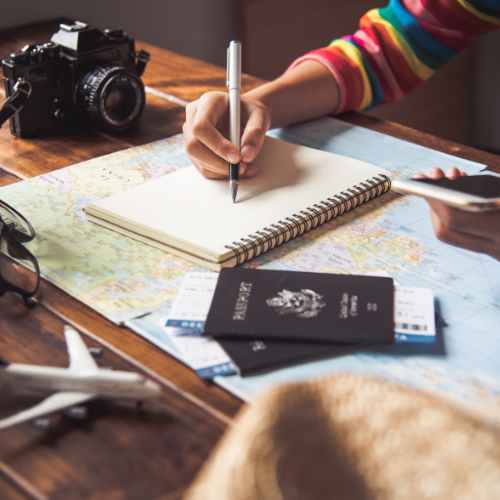Have you ever dreamed of exploring distant lands, immersing yourself in new cultures, and creating memories that last a lifetime? Planning an overseas trip can turn these dreams into reality. I remember my first journey abroad vividly – the mix of excitement and nervousness, the endless lists, and the thrill of stepping off the plane into a new world. It was a rollercoaster of emotions but absolutely worth it. In this blog, I want to share with you the joy and the challenges of planning an international trip.
Whether it’s your first time or you’re a seasoned traveler, this guide on how to plan an overseas trip will help you navigate through every step of the process.
Planning an international trip can seem overwhelming, but it’s all about breaking it down into manageable parts. From setting a budget to booking flights, from packing your bags to finally exploring your destination – there’s a lot to consider. But don’t worry! I’m here to walk you through how to plan a trip abroad, sharing not just tips and tricks but also my personal stories from trips that took me from the bustling streets of Paris to the serene beaches of Bali.
So, are you ready to embark on this exciting journey of planning an international trip? Let’s dive into the world of travel planning, where every step brings you closer to your dream destination.
Initial Considerations

Setting the Stage for Your Adventure
Before you start packing your bags, there are a few key decisions to make. These initial considerations are crucial in shaping your trip, making it both enjoyable and feasible.
Budgeting: The Foundation of Your Trip
Budgeting is perhaps the most critical aspect of planning an international trip. It determines where you can go, how long you can stay, and what activities you can enjoy. On my first trip to Japan, I learned the hard way that underestimating costs can lead to some tricky situations. To avoid this, start by outlining your major expenses: flights, accommodations, food, activities, and a little extra for those unforeseen expenses. Tools like budget calculators and travel apps can be a big help in this stage.
Related: Budgeting for Travel Made Easy: How to Explore More for Less
Choosing Your Destination: A World of Possibilities
Deciding where to go is both exciting and challenging. When planning a trip out of the country, consider factors like climate, peak travel seasons, and cultural events. Do you prefer a relaxing beach holiday or an action-packed city tour? Maybe you’re intrigued by historical sites? Each destination offers a unique experience, so pick one that aligns with your interests.
Trip Duration: Timing is Everything
How long can you travel? The duration of your trip impacts everything from your budget to your itinerary. It’s essential to balance your desire to explore with the practicalities of time off work and other commitments. Remember, even a short trip can be incredibly rewarding if well planned.
These initial steps are vital in planning international travel. They set the tone for your entire journey, helping you build a trip that’s not just feasible but also aligns with your dreams.
Useful Websites for Planning Your Trip:
- Skyscanner – for comparing flight prices.
- Budget Your Trip – for estimating and managing travel expenses.
- Lonely Planet – for destination ideas and travel guides.
- TripAdvisor – for hotel reviews and activity suggestions.
- XE Currency Converter – for currency conversion.
- World Weather & Climate Information – for climate and weather information of destinations.
Research and Documentation

Preparing for the Journey Ahead
With your budget set and destination chosen, it’s time to focus on the nitty-gritty details of how to plan a trip abroad. This stage is all about research and ensuring you have all the necessary documents for a hassle-free journey.
Travel Documents: Passport to the World
The first step in planning an international trip is to check your passport. Ensure it’s valid for at least six months beyond your planned return date. If you need a new passport or have to renew, start this process early, as it can take several weeks, or even months, to complete.
Visas are another critical aspect. Every country has different requirements based on your nationality. During a trip to Brazil, I learned the importance of early visa applications – a delay in processing almost cost me my trip! Check the embassy website of your destination country for up-to-date visa information and application procedures.
Understanding Local Customs and Language
When planning a trip to another country, it’s helpful to learn about local customs, etiquette, and basic phrases in the local language. This research not only enriches your travel experience but also shows respect for the culture you’re visiting. On my trip to Morocco, knowing a few Arabic greetings made a world of difference in how locals interacted with me.
Emergency Information and Contacts
Always be prepared for emergencies. Research local emergency numbers and addresses of embassies or consulates in your destination country. It’s also a good idea to inform someone at home of your travel plans and how to contact you.
Related: Essential Emergency Tips for Overseas Travel
Planning for these essentials is a crucial part of how to plan a trip out of the country. It ensures that you’re well-prepared for a smooth and enjoyable international journey.
Useful Resources for Research and Documentation:
- Passport Index – for checking passport strength and visa requirements.
- Duolingo – for learning basic phrases in the local language.
- Travel.State.Gov – for U.S. citizens to check travel documents and advisories.
- EmbassyPages – for finding embassies and consulates worldwide.
- Smart Traveler Enrollment Program (STEP) – for U.S. citizens to register their trip with the nearest U.S. Embassy or Consulate.
- Google Translate – for quick translation help.
Booking Flights and Accommodations

Securing Your Spot in the Sky and on the Ground
Now that the groundwork is laid, let’s get into the exciting part of how to plan international travel – booking your flights and accommodations. This phase can be a bit like a puzzle, fitting in dates, prices, and preferences to create the perfect trip.
Finding the Best Flight Deals
When it comes to planning international flights, timing and flexibility can save you a lot of money. I’ve found that booking several months in advance typically offers the best deals. However, if you’re more adventurous, last-minute bookings can sometimes yield surprisingly low prices. Websites and apps dedicated to comparing flight prices are invaluable tools. Don’t forget to consider alternative airports and indirect flights – they can offer significant savings.
Remember, the cheapest flight isn’t always the best option. Consider factors like layover times, total travel duration, and baggage policies. On a trip to Thailand, opting for a longer layover saved me hundreds of dollars, which I later used for an unforgettable elephant sanctuary visit.
Choosing Your Home Away from Home
Your choice of accommodation can dramatically influence your travel experience. When planning international travel, consider your priorities – is it location, comfort, budget, or maybe a mix of all three? Hotels offer convenience and services, hostels are great for meeting other travelers, and vacation rentals can provide a more local experience.
I’ve had great experiences with vacation rentals, especially in cities where hotels can be prohibitively expensive. They can offer a deeper dive into local life and often come with kitchen facilities, helping save on food costs.
Booking Websites and Reviews
Use booking websites and read reviews to get an idea of what to expect. But take reviews with a grain of salt – everyone’s experiences and preferences are different. On a trip to Rome, I chose a less-reviewed hotel which turned out to be a hidden gem, complete with a rooftop breakfast overlooking the city!
Related: Fly Smart: The Essential Guide to Flight Search Engines
Booking your flights and accommodations is a major step in how to plan a trip to another country. It’s where your plan starts to feel real – you now have a departure date, a return date, and a place to call home in a new part of the world.
Useful Websites for Booking Flights and Accommodations:
- Kayak – for comparing flight and hotel prices.
- Airbnb – for unique vacation rentals and experiences.
- Booking.com – for a wide range of hotel and accommodation options.
- Expedia – for comprehensive travel booking, including flights, hotels, and car rentals.
- Hostelworld – for finding and booking hostels worldwide.
Health and Safety Preparations

Ensuring a Healthy and Safe Travel Experience
An often overlooked but crucial part of how to plan for an international trip is considering your health and safety. This preparation can make a significant difference in your overall travel experience.
Vaccinations and Health Checks
Before heading abroad, check if your destination requires any specific vaccinations or health precautions. On a trip to Kenya, I had to get vaccinations for yellow fever and typhoid, which were mandatory for entry. It’s best to visit a travel clinic or your doctor well in advance, as some vaccinations need to be administered weeks before travel.
Don’t forget to pack a basic medical kit. Include items like pain relievers, antidiarrheals, band-aids, and any prescription medications you need. Always keep these in your carry-on luggage in case your checked bags get lost.
Travel Insurance and Health Coverage
Invest in good travel insurance that covers medical emergencies and evacuation. I learned its value during a trip when a friend had to visit a hospital in Peru. Without insurance, the costs would have been overwhelming.
Check your regular health insurance to see if it provides any coverage overseas. Often, domestic policies offer limited or no coverage abroad, making travel insurance even more essential.
Safety Tips and Awareness
When it comes to safety while planning an international trip, a little research goes a long way. Familiarize yourself with common scams and safety concerns in your destination. Always be aware of your surroundings, and keep your valuables secure and out of sight.
Stay informed about the local situation through travel advisories and news updates. Register with your embassy if they offer a traveler’s registration program. This step can be crucial for receiving assistance during political unrest or natural disasters.
Health and safety preparations are fundamental in how to plan an international trip. They ensure you can handle unexpected situations and focus on enjoying your adventure.
Useful Resources for Health and Safety Preparations:
- CDC Travel Vaccinations – for checking required vaccinations and health advice.
- World Health Organization – for global health updates and travel health information.
- TravelInsurance.com – for comparing and purchasing travel insurance.
- U.S. Department of State – Travel Advisories – for up-to-date travel advisories.
- Smart Traveler Enrollment Program (STEP) – for registering your trip with the U.S. Embassy.
Packing and Last-Minute Tips

The Art of Packing Smart and Final Preparations
Packing for an international journey is an art that balances necessity, convenience, and space. As we delve into how to plan a trip out of the country, let’s talk about packing effectively and those last-minute details that shouldn’t be overlooked.
Packing Essentials for International Travel
Start with a checklist. Think about the climate and cultural norms of your destination, and pack accordingly. For instance, when I traveled to India, light and modest clothing was essential due to the hot climate and cultural expectations.
Remember, less is often more. You don’t need to pack your entire wardrobe. Choose versatile items that can be mixed and matched. Also, leave some space for souvenirs and purchases you might make on your trip. Rolling clothes instead of folding them can save space and reduce wrinkles.
Don’t forget adapters and chargers for your electronics. Research the type of plug used in your destination and consider a universal travel adapter. It’s a lifesaver when you’re hopping between different countries.
Last-Minute Checks
As the departure date approaches, double-check your travel documents. Ensure your passport, visas, travel insurance, and flight tickets are all in order. It’s also a good idea to have digital copies of these documents saved online or in your email.
Notify your bank about your travel dates and destinations to avoid any issues with your credit or debit cards while abroad. Nothing is more stressful than having your card declined in a foreign country, something I learned the hard way in Prague.
Packing Your Carry-On
In your carry-on, pack essentials like important documents, a change of clothes, basic toiletries, and any medications you need. This preparation is crucial in case your checked luggage is delayed or lost. On a flight to Barcelona, my checked luggage went missing for two days, and having essentials in my carry-on was a lifesaver.
Useful Websites for Packing and Last-Minute Tips:
- Packing List App – for creating a customized packing list.
- Travel Fashion Girl – for tips on packing light and fashionably.
- World Plugs – for information on different types of plugs and sockets worldwide.
- Gov.uk Foreign Travel Advice – for updated travel documents and health advice.
- Travel Insurance Review – for comparing and selecting travel insurance.
- Nomad List – for insights on the digital and connectivity aspects of various destinations.
Packing and last-minute preparations are vital steps in how to plan for an international trip. They set the stage for a smooth and hassle-free start to your adventure.
On the Trip: Enjoying and Adapting Embracing the Journey with Open Arms
Finally, the moment you’ve been planning for is here! As you embark on your adventure, remember that the essence of how to plan an international trip lies not just in meticulous planning but also in your ability to enjoy and adapt.
Immersing in Local Culture
One of the most enriching aspects of international travel is the opportunity to immerse yourself in different cultures. Try local foods, participate in traditional activities, and engage with locals. On a trip to Japan, I ventured into a local festival unknown to most tourists. It was an unforgettable experience, filled with authentic interactions and insights into Japanese culture.
Staying Flexible and Adaptable
No matter how well you plan, unexpected changes are part of travel. Flights get delayed, weather changes, and plans can go awry. The key is to stay flexible. When I was in Italy, a train strike altered my plans drastically, but it led me to explore lesser-known towns that were incredibly charming and off the tourist path.
Dealing with Challenges
Challenges are inevitable, but they don’t have to ruin your trip. Lost luggage, language barriers, and navigation mishaps are common travel issues. Stay calm, think creatively, and use the resources available to you. Remember, every challenge is an opportunity to learn and grow.
Embracing the journey, with all its ups and downs, is a vital part of planning an international trip. It’s about making memories, growing personally, and enjoying the spontaneous moments that arise.
Useful Websites for Enjoying and Adapting During Your Trip:
- Wanderlog – for organizing and adapting your travel itinerary on the go.
- Duolingo – for learning basic phrases in the local language.
- Google Maps – for navigation and finding local attractions.
- XE Currency Converter – for on-the-spot currency conversions.
- TripIt – for keeping travel plans in one place.
- SitOrSquat – for finding restrooms in unfamiliar places.
Bonus Checklist: (right-click to save)

The World Awaits: Embrace the Adventure
As we wrap up this guide on how to plan an overseas trip, remember that the journey is as much about the planning as it is about the experiences you’ll gather. Each step, from budgeting to packing, from navigating airports to exploring new streets, is a part of the grand adventure that is international travel.
Planning an international trip can be daunting, but it’s also incredibly rewarding. The key is to be thorough in your preparations, flexible in your expectations, and open to the experiences that come your way. Whether it’s the joy of tasting a local dish for the first time or the awe of seeing a world-famous landmark, these moments make every bit of planning worthwhile.
So, go ahead and start planning your journey. The world is vast, and its wonders are waiting for you. Use this guide as a starting point to craft your own unique adventure. And most importantly, enjoy every step of the journey. Happy travels!
